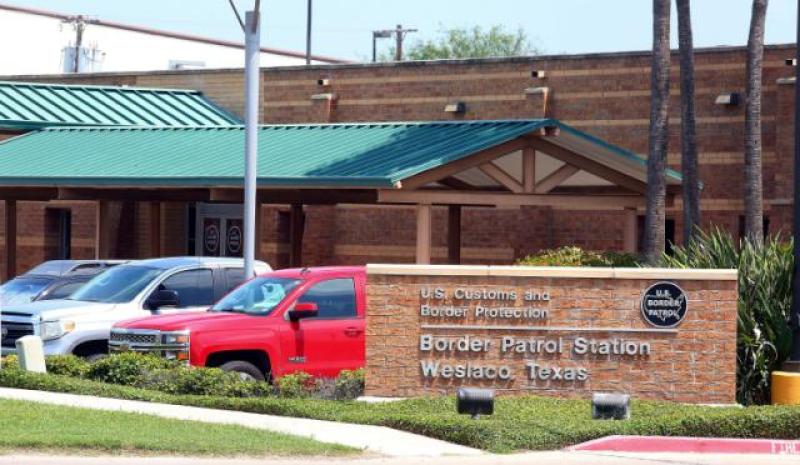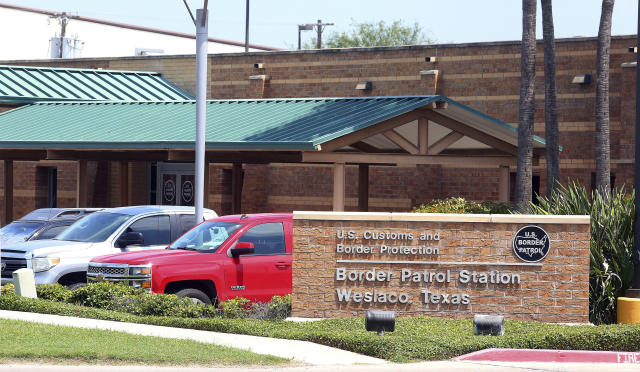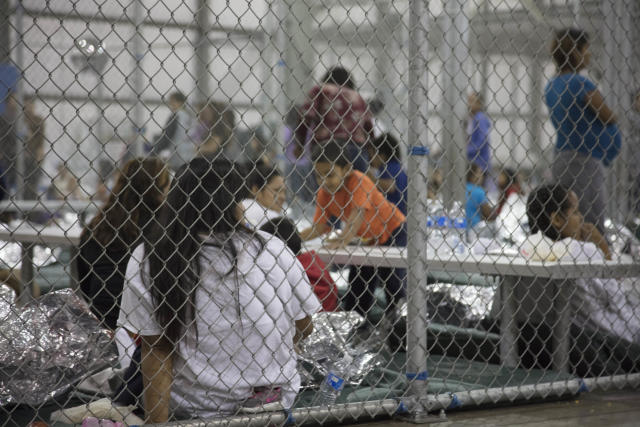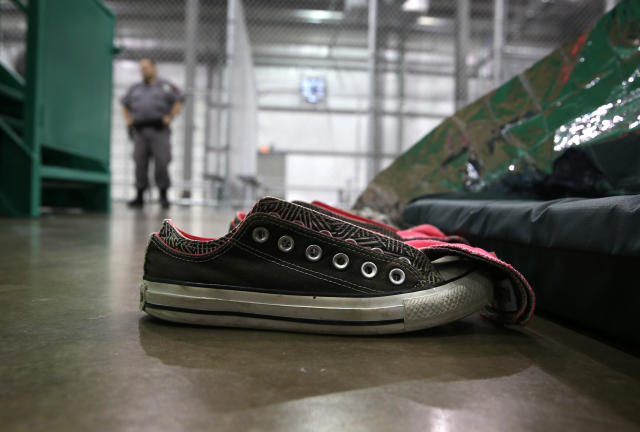Latest migrant child death raises questions about U.S. detention practices


Latest migrant child death raises questions about U.S. detention practices
 Caitlin Dickson 13 hours ago
Caitlin Dickson 13 hours ago

A Border Patrol station in Weslaco, Texas. (Photo: Joel Martinez/Monitor via AP)
Carlos Gregorio Hernandez Vasquez, a 16-year-old Guatemalan boy who died in U.S. custody in South Texas Monday, had been detained by border officials for twice as long as U.S. law allows, according to a timeline provided to reporters by a Customs and Border Protection official.
The fifth Guatemalan child to die after illegally crossing the border since December, Vasquez’s death at a Border Patrol station raises new questions about the length of time minors are being detained, as well as the conditions provided to them while in custody.
According to a CPB official familiar with the case, Vasquez was apprehended by Border Patrol agents near Hidalgo, Texas, on May 13 after crossing the border illegally with a group of 70 migrants. Within two hours of being taken into custody, Vasquez was transported to CBP’s Central Processing Center in McAllen — the agency’s largest immigrant processing facility and one of the primary settings for family separations under the Trump administration’s zero-tolerance policy. Upon arrival at CPC, Vasquez received a medical screening but received no recommendation for any kind of treatment or higher-level care at that time.
Under U.S. law , unaccompanied immigrant children from noncontiguous countries (i.e. anywhere other than Mexico or Canada) must be transferred to the custody of the Department of Health and Human Services Office of Refugee Resettlement within 72 hours after being apprehended.
However, according to the timeline provided to reporters Monday by a CBP official who declined to be quoted on the record, Vasquez was still at the CPC in McAllen on May 19, nearly a week after his arrival. In the early morning hours, he indicated to staff at the processing facility that he was not feeling well. The teen was then examined by a nurse practitioner, among the medical staff contracted by CBP to provide care to migrants at CPC and other facilities along the border, who determined that he had Influenza A and prescribed him Tamiflu, which Border Patrol agents picked up at a local pharmacy.
“Carlos continued to receive care at CPC throughout that day,” said the CBP official. Around midday, “in order to segregate him from much of other population at CPC,” the teen was transferred to the Weslaco Border Patrol station, approximately 22 miles away.

Border Patrol agents conduct intake of illegal border crossers at the Central Processing Center in McAllen, Texas. (Photo: U.S. Customs and Border Protection via Getty Images)
The CBP official told reporters that the agency had received confirmation on May 19 of initial placement for Vasquez at the Homestead temporary facility in southern Florida. The largest federally contracted children’s shelter in the country as of April 30 , the Homestead facility houses approximately 2,200 unaccompanied immigrant children between the ages of 13 and 17.
After learning of his illness, Vasquez’s placement at Homestead was withdrawn, the official said, and changed to the Casa Padre shelter in Brownsville, Texas, another massive facility for migrant children located in a former Walmart just 46 miles from Weslaco. The short drive to Brownsville was deemed “more appropriate than a long flight,” the CBP official explained.
On Monday morning — seven days after he was first apprehended at the border — Vasquez was found unresponsive in one of the short-term holding cells at the Weslaco station. It was not immediately clear whether he was being held alone or if there were others in the cell with him.
The exact cause and circumstances surrounding the Vazquez’s death are now under investigation by CBP, the FBI and the Weslaco Police Department. Though many questions remain unanswered at this point, one thing is clear from the official timeline: Vasquez had been in CBP custody for twice as long as legally allowed.
“This, sadly, doesn’t surprise me,” Leah Chavla, an attorney and policy adviser with the Women’s Refugee Commission who focuses rights of unaccompanied immigrant children, told Yahoo News. Chavla said that Vasquez’s delayed transfer to ORR custody is “consistent with reports we’ve been getting now for at least a month or so” from shelter staff, attorneys and other social service providers who work with unaccompanied immigrant kids.
Jennifer Podkul, policy director at Kids in Need of Defense, or KIND, an organization that provides pro bono legal services to immigrant children confirmed this trend.
“Our understanding [of] the delay is that CBP isn't able to do the screenings quickly enough to get the kids out in 72 hours,” Podkul said. “[The Office of Refugee Resettlement] has had open bed space so they haven't been full so it doesn't seem like the backup is on their end.”
The 72-hour policy for unaccompanied immigrant children was established under the 2008 William Wilberforce Trafficking Victims Protection Reauthorization Act, or the TVPRA. In response to flow of unaccompanied children and families from Central America to the southwest border, President Trump and members of his administration have been pushing for Congress to pass legislation that would roll back a number of existing legal protections, including those outlined in the TVPRA, that govern the detention of immigrant children.
Asked why Vasquez was not transferred to an appropriate shelter within the required timeframe, the CBP official offered a vague answer that seemed to point a finger at ORR. “Each individual is a case-by-case basis, ultimately ORR makes a determination as to which facilities they will be transporting subjects to and which individual demographics meet their available space,” the official said.

A scene from a detention facility run by the U.S. Border Patrol, McAllen, Texas. (Photo: John Moore/Getty Images).
In a statement to Yahoo News, Department of Health and Human Services spokesperson Mark Weber said “HHS has not rejected any referrals due to a lack of bed capacity” despite “the current historical refugee influx.” Weber did not, however, address the Vasquez case specifically.
“In the vast majority of cases,” Weber continued, “HHS has promptly designated a bed within 72 hours of DHS determining that the child is an unaccompanied alien child (UAC) and referring the child to HHS for placement. DHS then arranges transportation to the HHS shelter. The minority of cases exceeding 72 hours have generally involved exceptional circumstances, such as health issues unique to the UAC, or the placement of a sibling group to ensure they remain together.”
Before the December 2018 deaths of Jakelin Caal Maquin and Felipe Gómez Alonzo , two young Guatemalan migrants ages 7 and 8 who’d been apprehended by Border Patrol after crossing the border with their fathers within weeks of one another, no minor had died in CBP custody in over a decade. Outrage over those two deaths prompted congressional hearings and the implementation by CBP of additional medical screening procedures for children in their custody, particularly those under age 10.
The official who briefed reporters on Vasquez’s death noted that, since December 22, CBP agents across the southwest border have been transporting an average of “69 subjects per day to higher-level-care facilities, including urgent care as well as hospitals.”
In recent months, as the number of families with children arriving at the southwest border has swelled to record highs, Homeland Security Officials have sought additional funding from Congress to expand both personnel and physical capacity to accommodate this growing new population of migrants. At the same time, groups like KIND and WRC, along with the American Academy of Pediatrics have called for CBP facilities to employ specially-trained child welfare professionals to screen all children in CBP custody for signs of trafficking, abuse, fear of return, as well as potential health issues.
Earlier this month, another 16-year-old from Guatemala, Juan de León Gutiérrez , died at a Texas children’s hospital after he was brought to the Casa Padre shelter in Brownsville. Last week, a 2-year-old Guatemalan boy apprehended with his mother by Border Patrol agents near El Paso in early April died after spending weeks in the Providence Children’s Hospital. The toddler’s official cause of death has yet to be confirmed, but Guatemala’s Consul for the El Paso area told the Washington Post that the child, who spent three days in federal custody with his mother, had apparently contracted a form of pneumonia.
“More than anything, this is a disturbing pattern,” said Chavla, who stated that while Vasquez should’ve been in ORR custody, ultimately his death raises questions about the treatment and care of children detained at the border regardless of how long they’re in custody.
“It’s horrifying that this is yet again happening, and why is that?” she asked.
Tags
Who is online
89 visitors

Carlos Gregorio Hernandez Vasquez, a 16-year-old Guatemalan boy who died in U.S. custody in South Texas Monday, had been detained by border officials for twice as long as U.S. law allows, according to a timeline provided to reporters by a Customs and Border Protection official.
The fifth Guatemalan child to die after illegally crossing the border since December, Vasquez’s death at a Border Patrol station raises new questions about the length of time minors are being detained, as well as the conditions provided to them while in custody.
According to a CPB official familiar with the case, Vasquez was apprehended by Border Patrol agents near Hidalgo, Texas, on May 13 after crossing the border illegally with a group of 70 migrants. Within two hours of being taken into custody, Vasquez was transported to CBP’s Central Processing Center in McAllen — the agency’s largest immigrant processing facility and one of the primary settings for family separations under the Trump administration’s zero-tolerance policy. Upon arrival at CPC, Vasquez received a medical screening but received no recommendation for any kind of treatment or higher-level care at that time.
Under U.S. law , unaccompanied immigrant children from noncontiguous countries (i.e. anywhere other than Mexico or Canada) must be transferred to the custody of the Department of Health and Human Services Office of Refugee Resettlement within 72 hours after being apprehended.
However, according to the timeline provided to reporters Monday by a CBP official who declined to be quoted on the record, Vasquez was still at the CPC in McAllen on May 19, nearly a week after his arrival. In the early morning hours, he indicated to staff at the processing facility that he was not feeling well. The teen was then examined by a nurse practitioner, among the medical staff contracted by CBP to provide care to migrants at CPC and other facilities along the border, who determined that he had Influenza A and prescribed him Tamiflu, which Border Patrol agents picked up at a local pharmacy.
“Carlos continued to receive care at CPC throughout that day,” said the CBP official. Around midday, “in order to segregate him from much of other population at CPC,” the teen was transferred to the Weslaco Border Patrol station, approximately 22 miles away.
Earlier this month, another 16-year-old from Guatemala, Juan de León Gutiérrez , died at a Texas children’s hospital after he was brought to the Casa Padre shelter in Brownsville. Last week, a 2-year-old Guatemalan boy apprehended with his mother by Border Patrol agents near El Paso in early April died after spending weeks in the Providence Children’s Hospital. The toddler’s official cause of death has yet to be confirmed, but Guatemala’s Consul for the El Paso area told the Washington Post that the child, who spent three days in federal custody with his mother, had apparently contracted a form of pneumonia.
“More than anything, this is a disturbing pattern,” said Chavla, who stated that while Vasquez should’ve been in ORR custody, ultimately his death raises questions about the treatment and care of children detained at the border regardless of how long they’re in custody.
This is bound to happen when large numbers of illegals descend upon the border day after day and continue to overtax the capacity of the facilities which are understaffed, due to the willful lack of funding by the Democrats.
Contact your corresponding Congress critter and tell them to get off their asses and allocate funds for more personnel at all levels CPC. We need personnel, barriers, and advanced monitoring on the border to prevent crossings; more detention centers built and fully staffed; more personnel to process illegal immigrants; and especially more judges to get those with asylum claims processed.
Or, watch the government continue to do nothing and just bitch about it as a political prop to try and get votes.